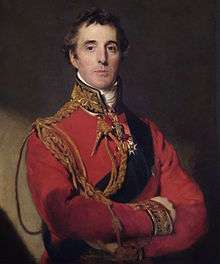Garret Wesley, 1st Earl of Mornington
Garret Colley Wesley, 1st Earl of Mornington (19 July 1735 – 22 May 1781) was an Anglo-Irish politician and composer, best known today for fathering several distinguished military commanders and politicians of Great Britain and Ireland.
The Earl of Mornington | |
|---|---|
| 1st Earl of Mornington | |
 Dangan Castle, in the County of Meath, c. 1840 | |
| Tenure | 1760-1781 |
| Predecessor | Richard Wesley, 1st Baron Mornington |
| Successor | Richard Wellesley, 2nd Earl of Mornington |
| Other titles | Viscount Wellesley of Dangan Castle, in the County of Meath |
| Known for | Father of the Duke of Wellington |
| Born | 19 July 1735 Dangan Castle, in County Meath |
| Died | 22 May 1781 (aged 45) |
| Nationality | Irish |
| Offices | Member of Parliament for Trim Grandmaster of the Grand Lodge of Ireland |
| Spouse(s) | Anne Hill-Trevor |
| Parents | Richard Wesley, 1st Baron Mornington Elizabeth Sale |
Life
Wesley was born at the family estate of Dangan Castle, near Summerhill, a village near Trim in County Meath, Ireland, to Richard Wesley, 1st Baron Mornington, and Elizabeth Sale. He was educated at Trinity College Dublin, and was elected its first Professor of Music in 1764. From early childhood he showed extraordinary talent on the violin, and soon began composing his own works.[1] As a composer he is remembered chiefly for glees such as "Here in cool grot" (lyrics by William Shenstone) and for a double Anglican chant. It was the future Duke of Wellington who, alone of his children, inherited something of his musical talent.
Wesley represented Trim in the Irish House of Commons from 1757 until 1758, when he succeeded his father as 2nd Baron Mornington. In 1759 he was appointed Custos Rotulorum of Meath and in 1760, in recognition of his musical and philanthropic achievements, he was created Viscount Wellesley, of Dangan Castle in the County of Meath, and Earl of Mornington. He was elected Grandmaster of the Grand Lodge of Ireland in 1776, a post he held until the following year.[2] Like his father he was careless with money, and his early death left the family exposed to financial embarrassment, leading ultimately to the decision to sell all their Irish estates.[3]
Legacy
Four streets in Camden Town, which formed part of the estate of his son-in-law Henry FitzRoy, were named Mornington Crescent, Place, Street and Terrace after him. Of these, the first has since become famous as the name of a London Underground station.[4]
Family
Wesley married The Hon. Anne Hill-Trevor, eldest daughter of the banker Arthur Hill-Trevor, 1st Viscount Dungannon, and his wife Anne Stafford, on 6 February 1759. His godmother, the famous diarist Mary Delany, said the marriage was happy, despite his lack of financial sense and her "want of judgment".[5] They had nine children, most of them were historically significant:
- Richard, Viscount Wellesley (20 June 1760 – 26 September 1842); later 1st Marquess Wellesley, 2nd Earl of Mornington.
- Arthur Gerald Wellesley (? - 1768), named after his maternal grandfather and died at six or seven.
- The Hon. William Wellesley (20 May 1763 – 22 February 1845); later William Wellesley-Pole, 3rd Earl of Mornington, 1st Baron Maryborough.
- Francis Wellesley (1767 - 10 March 1770), died at three.
- Lady Anne Wellesley (13 March 1768 – 16 December 1844), married (1) The Hon. Henry FitzRoy (younger son of Charles FitzRoy, 1st Baron Southampton), (2) Charles Culling Smith.
- The Hon. Arthur Wellesley (c. 1 May 1769 – 14 September 1852); later 1st Duke of Wellington.
- The Revd and Hon. Gerald Valerian Wellesley (7 December 1770 – 24 October 1848), father of George Wellesley.
- Lady Mary Elizabeth Wellesley (1772 – 1794), died at 22.
- The Hon. Henry Wellesley (20 January 1773 – 27 April 1847); later 1st Baron Cowley.
Four of Lord Mornington's five sons were created peers in the Peerages of Great Britain and the United Kingdom. The Barony of Wellesley (held by the Marquess Wellesley) and the Barony of Maryborough are now extinct, whilst the Dukedom of Wellington and Barony of Cowley are extant. The Earldom of Mornington is held by the Dukes of Wellington, and the Barons Cowley has since been elevated to be Earls Cowley.
References
- Longford, Elizabeth Wellington. The Years of the Sword Panther Edition, 1971, p. 32.
- Waite, Arthur Edward (2007). A New Encyclopedia of Freemasonry. vol. I. Cosimo, Inc. p. 400. ISBN 1-60206-641-8.
- Longford p.53
- Weinreb, Ben and Hibbert, Christopher (1992). The London Encyclopaedia (reprint ed.). Macmillan. p. 543.CS1 maint: uses authors parameter (link)
- Longford p. 33.
External links
- Webb, Alfred (1878). . A Compendium of Irish Biography. Dublin: M. H. Gill & son – via Wikisource.
- Article from thepeerage.com
- Free scores by Garret Wesley, 1st Earl of Mornington in the Choral Public Domain Library (ChoralWiki)
- Free scores by Garret Wesley, 1st Earl of Mornington at the International Music Score Library Project (IMSLP)
| Parliament of Ireland | ||
|---|---|---|
| Preceded by Chichester Fortescue Joseph Ashe |
Member of Parliament for Trim 1757–1758 With: Joseph Ashe |
Succeeded by William Francis Crosbie Joseph Ashe |
| Masonic offices | ||
| Preceded by The Earl of Belvedere |
Grand Master of the Grand Lodge of Ireland 1776 – 1777 |
Succeeded by The Duke of Leinster |
| Peerage of Ireland | ||
| New creation | Earl of Mornington 1760 – 1781 |
Succeeded by Richard Wellesley |
| Preceded by Richard Wesley |
Baron Mornington 1758 – 1781 | |
